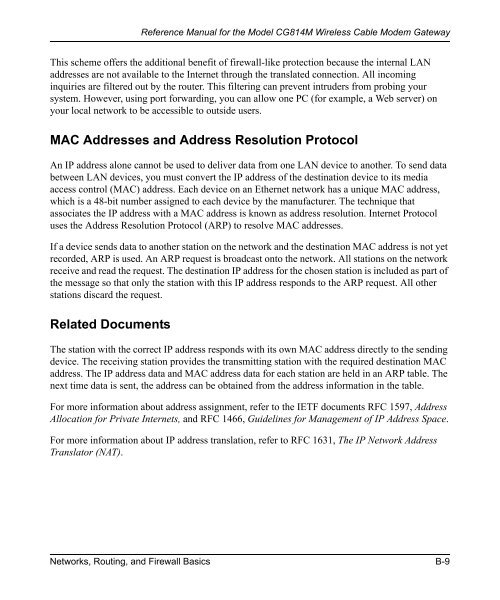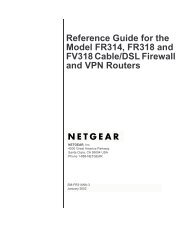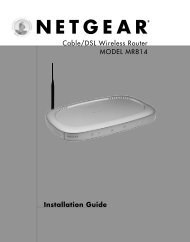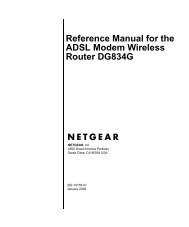Reference Manual for the Model CG814M Wireless Cable ... - netgear
Reference Manual for the Model CG814M Wireless Cable ... - netgear
Reference Manual for the Model CG814M Wireless Cable ... - netgear
You also want an ePaper? Increase the reach of your titles
YUMPU automatically turns print PDFs into web optimized ePapers that Google loves.
<strong>Reference</strong> <strong>Manual</strong> <strong>for</strong> <strong>the</strong> <strong>Model</strong> <strong>CG814M</strong> <strong>Wireless</strong> <strong>Cable</strong> Modem Gateway<br />
This scheme offers <strong>the</strong> additional benefit of firewall-like protection because <strong>the</strong> internal LAN<br />
addresses are not available to <strong>the</strong> Internet through <strong>the</strong> translated connection. All incoming<br />
inquiries are filtered out by <strong>the</strong> router. This filtering can prevent intruders from probing your<br />
system. However, using port <strong>for</strong>warding, you can allow one PC (<strong>for</strong> example, a Web server) on<br />
your local network to be accessible to outside users.<br />
MAC Addresses and Address Resolution Protocol<br />
An IP address alone cannot be used to deliver data from one LAN device to ano<strong>the</strong>r. To send data<br />
between LAN devices, you must convert <strong>the</strong> IP address of <strong>the</strong> destination device to its media<br />
access control (MAC) address. Each device on an E<strong>the</strong>rnet network has a unique MAC address,<br />
which is a 48-bit number assigned to each device by <strong>the</strong> manufacturer. The technique that<br />
associates <strong>the</strong> IP address with a MAC address is known as address resolution. Internet Protocol<br />
uses <strong>the</strong> Address Resolution Protocol (ARP) to resolve MAC addresses.<br />
If a device sends data to ano<strong>the</strong>r station on <strong>the</strong> network and <strong>the</strong> destination MAC address is not yet<br />
recorded, ARP is used. An ARP request is broadcast onto <strong>the</strong> network. All stations on <strong>the</strong> network<br />
receive and read <strong>the</strong> request. The destination IP address <strong>for</strong> <strong>the</strong> chosen station is included as part of<br />
<strong>the</strong> message so that only <strong>the</strong> station with this IP address responds to <strong>the</strong> ARP request. All o<strong>the</strong>r<br />
stations discard <strong>the</strong> request.<br />
Related Documents<br />
The station with <strong>the</strong> correct IP address responds with its own MAC address directly to <strong>the</strong> sending<br />
device. The receiving station provides <strong>the</strong> transmitting station with <strong>the</strong> required destination MAC<br />
address. The IP address data and MAC address data <strong>for</strong> each station are held in an ARP table. The<br />
next time data is sent, <strong>the</strong> address can be obtained from <strong>the</strong> address in<strong>for</strong>mation in <strong>the</strong> table.<br />
For more in<strong>for</strong>mation about address assignment, refer to <strong>the</strong> IETF documents RFC 1597, Address<br />
Allocation <strong>for</strong> Private Internets, and RFC 1466, Guidelines <strong>for</strong> Management of IP Address Space.<br />
For more in<strong>for</strong>mation about IP address translation, refer to RFC 1631, The IP Network Address<br />
Translator (NAT).<br />
Networks, Routing, and Firewall Basics B-9
















